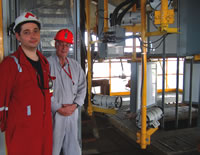 An automated wire rope inspection system developed as a result of an R&D project by the Sudbury-based Deep Mining Research Consortium and AMIRA has successfully replaced the decades-old practice of daily, manual hoist rope inspections at Xstrata Copper’s Kidd D Mine in Timmins.
An automated wire rope inspection system developed as a result of an R&D project by the Sudbury-based Deep Mining Research Consortium and AMIRA has successfully replaced the decades-old practice of daily, manual hoist rope inspections at Xstrata Copper’s Kidd D Mine in Timmins.
Installed in April 2006 following pilot installations at Vale Inco’s Garson Mine in Sudbury and BHP Billiton’s Leinster Mine in Australia, the computer visioning system performs a 360 degree inspection of ropes and detects broken wires with the hoist skipping ore at full speed.
Manual inspection used to take the hoist out of service for an hour each day, reducing hoist availability. With more ore being skipped, Xstrata’s return on investment for the automated wire rope inspection system is a mere 30 days, said Andrew Young, who managed the R&D project and is now commercializing the system through Seer Technologies under license from Vale Inco.
The system consists of a series of video cameras and software that detects and reports on anomalies, allowing inspectors to examine images of potential defects off-line.
The system not only increases hoist availability, but also improves safety, said Young. Manual inspection with the hoist slowed to 150 feet per minute was a monotonous task easily compromised if the inspector had a bad night or was distracted for any reason.
“Even the health and safety people at Kidd, who were originally skeptical about the system, are now very much in favour of it. They think it’s a fantastic solution to the problem of having men spending a half hour in a very boring situation.
“Mining companies are very conservative, so the fact that Kidd was first was very courageous,” said Young.
“Usually, they will adopt new technology only after someone else has found it to be successful.”
There is a second commercial application of the technology at Xstrata Copper’s Mt. Isa Mine in Australia and two other systems on order – one for Newcrest Mining’s Telfer Mine in Western Australia and the other for BHP Billiton’s Leinster property, site of a pilot deployment in 2005.
Government regulators are also endorsing the solution, exempting mines with automated systems from daily visual inspections in Western Australia.
“The (Ontario) Ministry of Labour inspector who came to look at our system at Kidd gave us the ‘no issues at this time’ report and said ‘This is the official report, but, personally, I love it.’ The reason he loved it is he used to personally inspect rope at Kidd, so he knows what the problem is,” said Young.
The Ministry of Labour refrains from officially endorsing a safety practice to avoid liability, hence the “no issue” report.
Systems are available for single and double drum hoists, as well as Koepe hoists with up to eight ropes.
There have been several refinements to the system since its initial deployment – one being real-time analysis.
“The thing about the Koepe system is that because you have all these ropes going down at the same time, you literally have no choice but to capture the images and analyze them on the fly,” said Young. “The ropes at Mt. Isa are 4,000 feet, so we’re capturing and analyzing 4,000 images times four ropes in real-time. It’s a significant advantage because this gives you the opportunity for instant alarms.”
Seer Technologies has also been asked for further enhancements to measure lay length and rope diameter.
Maintenance of systems such as these can be a huge cost, but the automated wire rope inspection system is Web-enabled, allowing Seer Technologies staff to remotely access the cameras and watch maintenance staff repair the system in Timmins or Australia.
“About a month ago, Kidd called to report the system wasn’t working, so we dialed in and discovered there was a problem with one of the light panels,” said Young. “We got the guys from Kidd to go down there and, while they were working on the light panel, we were able to talk to them from our control centre in St. John’s, Newfoundland, and watch what they were doing over the Internet. When they put the light panel back, we asked them to move it two inches because it wasn’t quite in the right place.”
With rave reviews from early adopters, expressions of interest from several Canadian mines, and an agent making presentations to mines in South Africa, Young predicts there will be 10 systems in place by the end of the year.


